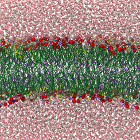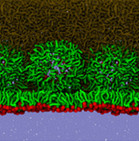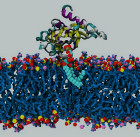Current research projects
Lipid Bilayers

Lipid bilayers bilayers are main constituents of cell membranes which enclose each living cell and act as complex, partialy permeable berriers between the cell and its environment. Each living cell transfers various material in and out across its cellular membrane. Moreover, bacteria and viruses always encounter the membrane when attacking a cell. Similarly, if we want to transport a drug molecule into a cell we must find a way to transfer it across the membrane. These three examples show why it is crucial to gain a molecular-level understanding of lipid membranes.
Tear Film Lipid Layer

Tear Film Lipid Layer is a thin layer of lipids that covers the ocular surface of human eye. Its main function is reduction of the surface tension of the tear film/air interface. Moreover, the presence of the TFLL prevents rapid evaporation of water from the underlying water aqueous phase. TFLL deficiencies lead to evaporative dry eye syndrome, one of the commonly reported eye ailments. Despite its vital role for eye function, the structure and other properties of TFLL at the molecular level are essentially unknown and only recently studied. We recently constructed a computational model of the TFLL and currently we employ it to investigate structure and dynamics of the TFLL.
Lipid Mono- and Multilayers

Lipid mono- and multilayers at water/air boundary are interesting preliminarily in the context of the lung surfactant. The gas exchange in lungs occurs through a layer of lipids that covers the surface of lung alveoli cells. This lipid layer is a first line of defense between air and the organism and is prone to a damage by such environmental factors as free radicals and air pollutants. On the other hand, this barrier is relatively easy to cross and may serve as convenient drug delivery path. This is why we try to better understand lipid monolayers at the level of individual molecules.
Transmembrane Peptides

Some of the membrane proteins that span across cell membrane have a relatively simple transmembrane domain that still is able to control protein's behavior. Moreover, this domain is directly interacting with membrane lipids, hence it influences membrane properties. Similarly, the lipid-protein interactions modulate protein behavior. These issues cannot be understood without a knowledge about lipid-protein interactions at the level of individual chemical moieties.